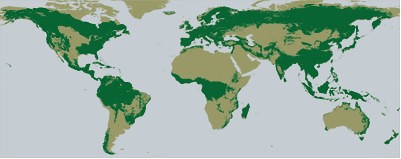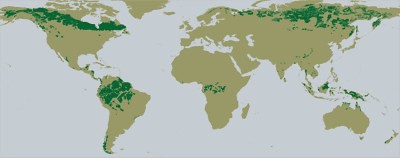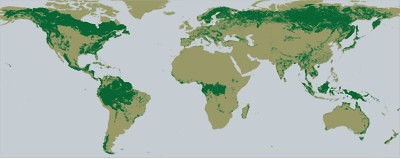Seeing the Forest for the Trees . . .
August 3rd, 2007 by Hilary
For the last hundred years, Earth has experienced a rapid loss of forested area. Reports continue to indicate huge forests losses.
Almost half of the planet’s original forest has been destroyed, mostly during the last three decades. Between 1990 and 1995, the net forest loss equaled 33 football fields per minute (112 600 square kilometers annually).
About 47 percent of the world’s forests occur in the tropical zone, 9 percent in the subtropics, 11 percent in the temperate zone and 33 percent in the boreal zone. In the tropics, about half of the mature forests, between 750 to 800 million hectares of the original 1.5 to 1.6 billion hectares, have been felled. Between 1990 and 2000 alone, natural forests in the tropics disappeared at an annual rate of fourteen million hectares, a rate of loss of an acre a second. Between 1960 and 1990, about 20 percent of total tropical forest cover was lost.
We often think of the value of forests as the returns they provide in the way of firewood, office paper, newspaper, construction timber, plywood, and wood for furniture. We forget the other services they provide. Forests serve as the world’s major air filter removing carbon monoxide and other air pollutants. Trees also help perpetuate the water cycle by returning water vapor back into the atmosphere. Thus, forests modulate climate at local and regional levels through rainfall. Without trees to fill these roles, many former forestlands can quickly become barren deserts. By preserving watershed functions, they regulate water flows in terms of both quantity and quality. Here, in the Northwest we are well aware of how tree coverage protects the land surface against landslides, erosion, and sediment runoff into streams and shorelines. Finally, forests provide critical habitat for a significant number of species. For example, the tropical forests represent 6% of the world’s land surface but hold between 50% and 80% of the world’s terrestrial species of plants and animals.
Most notably, forests and their soils are a major sink for carbon, making deforestation a significant factor in global warming. After carbon emissions caused by humans, deforestation is a principle cause of atmospheric CO2. Deforestation accounts for roughly 20 percent of global carbon emissions. Halting deforestation over the next 50 years would protect important habitat while also providing around 15 percent of the carbon-emissions reductions needed to stabilize global temperatures.
Exbiblio’s recent grant to the Wildlands Project and Naturalia is just one example of the many efforts to protect critical forests worldwide. The grant goes to a project to protect 6,000 acres of old-growth forest in the Sierra Madres. The Sierra Madres in Mexico has some of the richest, rarest, and most endangered terrestrial natural areas on Earth. Indeed, scientists have identified this area as one of the most critical global regions for conservation. Through a partnership with the local eijido members and the Wildlands Project and Naturalia, these conservation organizations provide lease payments for 15 years in exchange for the eijido community agreeing not to log the forest.
During those 15 years, the organizations and the eijido will take steps to create economic value for the community through preserving the forest instead of logging it. Both parties are working to promote eco-tourism given half of the breeding population of the thick-billed parrot lives on the 6,000 acres. Additionally, a forest study will be completed for the remainder of the ejido’s land (approximately 35,000 acres), which will result in a sustainable logging plan. Finally, the ejido receives $597,000 pesos (approximately $60,000 US) over the next five years from a new program by the National Forest Commission that places a market value on environmental services provided by forests (such as clean water), and pays rural communities for providing those services. This combined with the lease payments, provides each ejido member with approximately $10,000 pesos ($1,000 US) per year for environmental services rendered – more than they would have received if they had accepted the logging contract. It is an example of how conserving the forest can provide environmental as well as economical returns for a community. It is an example of how trees have more value alive than dead.





January 3rd, 2008 at 11:35 pm
Industrialization ramped humankind towards extinction, the mistake becomes more obvious but my money’s on the planet – mother nature will have the last word after we’re gone; after we’re gone the trees will return.